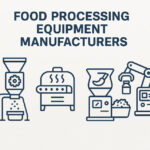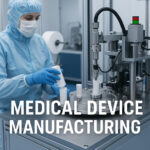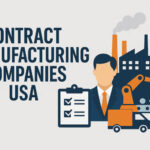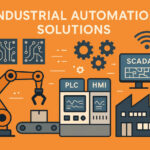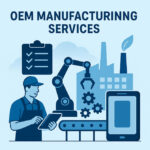The global food industry is one of the most critical sectors in the world. From large commercial bakeries to meat-packing plants and beverage companies, food production relies heavily on advanced machinery to ensure quality, efficiency, and safety. Behind the scenes, food processing equipment manufacturers play a crucial role in designing and building the machines that make mass food production possible.
This article explores:
- What food processing equipment is
- The role of manufacturers in the industry
- Types of equipment they produce
- Key sectors they serve
- Latest trends and technologies
- Challenges they face
- How to choose the right equipment supplier
What Is Food Processing Equipment?
Food processing equipment refers to the machines and tools used to prepare, cook, package, and preserve food. These machines help convert raw agricultural ingredients into safe, edible, and market-ready food products. They must comply with strict regulations for hygiene, material handling, and safety.
Examples of food processing include:
- Cutting and chopping vegetables
- Mixing and blending sauces
- Pasteurizing milk
- Freezing prepared meals
- Filling and sealing jars and bottles
Modern food processing lines are automated, high-speed, and often custom-engineered to meet the specific needs of the product and the producer.
Who Are Food Processing Equipment Manufacturers?
Food processing equipment manufacturers are companies that design, engineer, and build machinery used in the food industry. These manufacturers can be:
- Large multinational corporations
- Specialized firms focusing on niche food categories
- Custom fabricators offering tailor-made solutions
Their machines must meet high standards of:
- Durability
- Ease of cleaning
- Energy efficiency
- Automation compatibility
- Regulatory compliance (e.g., FDA, USDA, CE, ISO)
In addition to production, many manufacturers also offer installation, training, maintenance, and after-sales support.
Major Types of Food Processing Equipment
Each stage in the food processing cycle requires specific machines. Below are some of the most common categories:
1. Pre-Processing Equipment
Used for cleaning, grading, and preparing raw materials.
- Washers and peelers
- Graders and sorters
- Destoners and dewatering machines
2. Cutting and Slicing Equipment
Used to reduce food size uniformly for further processing.
- Slicers
- Dicers
- Grinders
- Choppers
3. Mixing and Blending Equipment
Combine ingredients into homogenous mixtures.
- Ribbon blenders
- Paddle mixers
- Dough kneaders
- Emulsifiers
4. Cooking and Thermal Processing
Apply heat to cook or sterilize food.
- Ovens
- Steamers
- Pasteurizers
- Retorts
- Fryers
5. Cooling and Freezing Equipment
Rapidly reduce temperature to preserve freshness.
- Blast chillers
- Tunnel freezers
- Spiral freezers
6. Filling and Packaging Equipment
Portion food into containers and seal them.
- Fillers
- Cappers
- Wrappers
- Vacuum sealers
- Labelers
7. Conveying Systems
Move materials and products through different stages.
- Belt conveyors
- Screw conveyors
- Pneumatic conveyors
- Bucket elevators
8. Inspection and Quality Control Equipment
Ensure product quality and safety.
- Metal detectors
- X-ray inspection systems
- Checkweighers
- Vision systems
Industries Served by Equipment Manufacturers
Food processing equipment manufacturers serve a wide variety of food sectors:
1. Meat and Poultry
Equipment for deboning, grinding, slicing, marinating, and packaging meats.
2. Bakery and Confectionery
Machines for dough handling, proofing, baking, decorating, and wrapping.
3. Dairy
Systems for pasteurizing, fermenting, homogenizing, and packaging milk, cheese, and yogurt.
4. Fruits and Vegetables
Equipment for washing, slicing, blanching, drying, and freezing.
5. Beverages
Processing and bottling lines for juices, soft drinks, beer, and water.
6. Seafood
Filleting, smoking, freezing, and canning solutions for fish and shellfish.
7. Snacks and Ready Meals
Processing and packaging systems for chips, frozen dinners, sauces, and more.
Top Global Food Equipment Manufacturers
Some of the most reputable names in the industry include:
- GEA Group (Germany) – Wide range of processing and packaging solutions.
- Tetra Pak (Sweden) – Specializes in liquid food packaging.
- Bühler Group (Switzerland) – Known for grain processing and milling equipment.
- Marel (Iceland) – Leading provider in meat and fish processing equipment.
- JBT Corporation (USA) – Offers freezing, cooking, and packaging technologies.
- SPX FLOW (USA) – Provides systems for dairy, beverages, and processed foods.
These companies often collaborate with food producers on large-scale projects and offer integrated automation systems.
Key Considerations in Equipment Design
Modern food processing machines are built with several key factors in mind:
1. Hygiene and Sanitation
Equipment must be easy to clean, with smooth surfaces, stainless steel construction, and no hidden crevices that trap bacteria.
2. Food Safety Compliance
Machines must meet regional standards such as:
- USDA and FDA (United States)
- CE (Europe)
- HACCP guidelines
- 3-A Sanitary Standards
3. Energy and Water Efficiency
Manufacturers design machines to use less power and water, which lowers operational costs and supports sustainability.
4. Automation and Smart Controls
Equipment includes PLC systems, touchscreen HMIs, and remote diagnostics to simplify operation and maintenance.
5. Scalability
Whether a startup or multinational brand, businesses need systems that can grow with production demands.
Latest Trends in Food Processing Equipment
The industry is evolving rapidly to meet changing consumer habits and technological innovations.
1. Automation and Robotics
Robotic arms, pick-and-place systems, and AI-driven controls are reducing labor costs and improving precision.
2. Clean Label and Allergen Control
Equipment must now process allergen-free products in dedicated lines and allow rapid changeovers for clean-label foods.
3. Modular Design
Machines with modular components allow quicker setup, maintenance, and line expansion.
4. Sustainable Engineering
Manufacturers are using recyclable materials, low-emission processes, and energy-saving motors.
5. Digital Twin Technology
Virtual simulations of processing lines allow companies to test layouts and optimize operations before installing equipment.
Challenges Faced by Manufacturers
Even in a growing market, food processing equipment manufacturers face several challenges.
1. Strict Regulatory Compliance
Adapting machines to meet diverse food safety regulations in different countries can be complex and costly.
2. Customization Demands
Food processors increasingly demand tailored machines, requiring flexible engineering and design.
3. Labor Shortages
Manufacturers must design systems that are intuitive to operate and require minimal manual intervention.
4. Supply Chain Disruptions
Global supply chain issues can delay delivery of parts and materials, affecting lead times.
5. High R&D Costs
Developing cutting-edge machines with automation, AI, and IoT capabilities requires significant investment.
How to Choose the Right Equipment Manufacturer
Selecting the right partner is crucial for your production goals and long-term success.
1. Industry Experience
Do they specialize in your product category (e.g., meat, bakery, dairy)?
2. Equipment Range
Can they offer a complete line or just one machine?
3. Customization Options
Are they willing to modify designs to fit your space or recipe needs?
4. Technical Support
Do they offer installation, training, and 24/7 maintenance?
5. Regulatory Compliance
Is their equipment certified and compliant with local laws?
6. References and Reviews
Can they provide case studies or references from other clients?
Case Study: Small Dairy Scales Up with Modular Equipment
A mid-sized dairy in Wisconsin wanted to expand its line of organic yogurt without changing facilities. They partnered with a manufacturer that offered modular fermentation tanks, automated filling lines, and CIP (Clean-in-Place) systems. Within six months, the dairy doubled production capacity, improved product consistency, and cut labor by 25%.
The Future of Food Equipment Manufacturing
The future is smart, sustainable, and collaborative. Here’s what to expect:
1. AI-Powered Quality Control
Machine vision and AI will detect defects, monitor hygiene, and predict failures.
2. Green Manufacturing
Companies will focus on low-carbon, low-waste, and recyclable machine components.
3. Greater Customization
Machines will become more modular, allowing processors to switch between product lines rapidly.
4. Integration with ERP and MES
Equipment will be digitally connected to enterprise systems for real-time tracking and automated decision-making.
Conclusion
Food processing equipment manufacturers are vital to the modern food supply chain. From automating tedious tasks to ensuring food safety, their machines keep supermarkets stocked, consumers fed, and businesses profitable.
As demand for processed food grows, these manufacturers will continue to innovate with smarter, greener, and more flexible technologies. Whether you’re a startup launching a new food product or a multinational expanding operations, choosing the right equipment partner can make all the difference.

